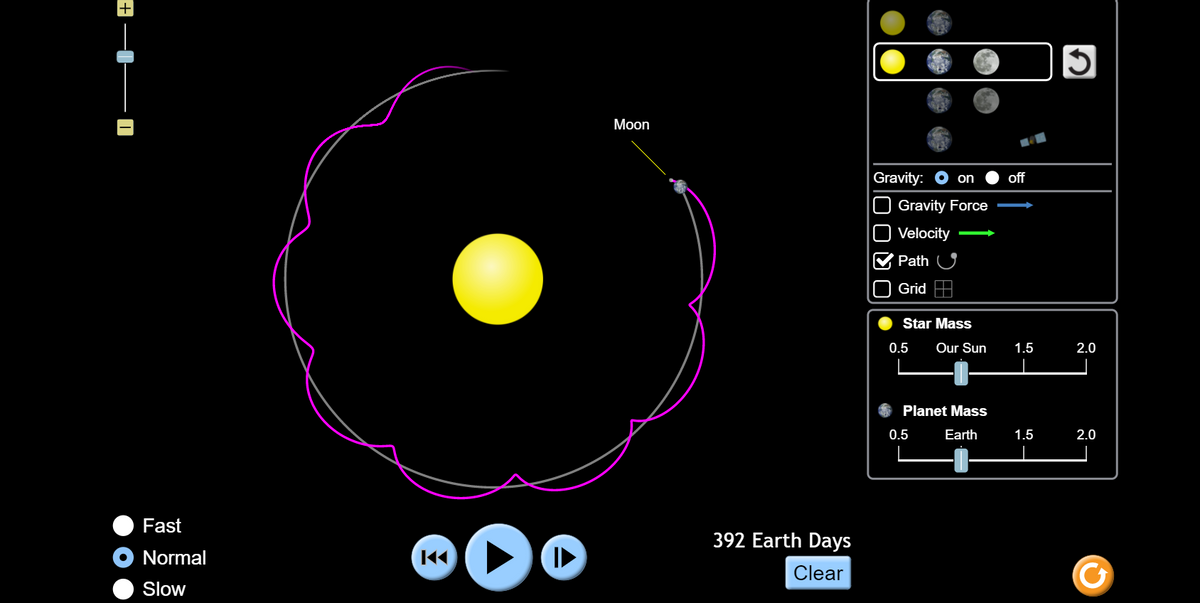night sky and why the phases of the moon repeat approximately once a month. Draw a picture that shows the approximate relative positions of the Earth, Moon, and Sun during the night that a full moon may be visible. (a rough sketch is okay).
night sky and why the phases of the moon repeat approximately once a month. Draw a picture that shows the approximate relative positions of the Earth, Moon, and Sun during the night that a full moon may be visible. (a rough sketch is okay).
College Physics
1st Edition
ISBN:9781938168000
Author:Paul Peter Urone, Roger Hinrichs
Publisher:Paul Peter Urone, Roger Hinrichs
Chapter34: Frontiers Of Physics
Section: Chapter Questions
Problem 15CQ: What are gravitational waves, and have they yet been observed either directly or indirectly?
Related questions
Question

Transcribed Image Text:Мon
Gravity:
on
off
O Gravity Force
Velocity
>
Path U
Grid
Star Mass
0.5
Our Sun
1.5
2.0
Planet Mass
0.5
Earth
1.5
2.0
Fast
392 Earth Days
Normal
Clear
Slow

Transcribed Image Text:c) While the Moon orbits the Earth, the Earth is spinning about its own axis, spinning around
approximately once per day (producing the day and night cycle). This means that at nighttime,
when your location on Earth faces away from the Sun, the Moon will be positioned at varying
angles relative to the Sun. You will see a different portion of the Moon illuminated by the sun on
each night, until the Moon completes its orbit around the Earth, at which point the pattern of
illumination repeats. This is what produces the "phases" of the moon that we observe in the
night sky and why the phases of the moon repeat approximately once a month. Draw a picture
that shows the approximate relative positions of the Earth, Moon, and Sun during the night that
a full moon may be visible. (a rough sketch is okay).
Expert Solution
This question has been solved!
Explore an expertly crafted, step-by-step solution for a thorough understanding of key concepts.
Step by step
Solved in 2 steps with 1 images

Knowledge Booster
Learn more about
Need a deep-dive on the concept behind this application? Look no further. Learn more about this topic, physics and related others by exploring similar questions and additional content below.Recommended textbooks for you

College Physics
Physics
ISBN:
9781938168000
Author:
Paul Peter Urone, Roger Hinrichs
Publisher:
OpenStax College

Stars and Galaxies (MindTap Course List)
Physics
ISBN:
9781337399944
Author:
Michael A. Seeds
Publisher:
Cengage Learning


College Physics
Physics
ISBN:
9781938168000
Author:
Paul Peter Urone, Roger Hinrichs
Publisher:
OpenStax College

Stars and Galaxies (MindTap Course List)
Physics
ISBN:
9781337399944
Author:
Michael A. Seeds
Publisher:
Cengage Learning


Foundations of Astronomy (MindTap Course List)
Physics
ISBN:
9781337399920
Author:
Michael A. Seeds, Dana Backman
Publisher:
Cengage Learning

Astronomy
Physics
ISBN:
9781938168284
Author:
Andrew Fraknoi; David Morrison; Sidney C. Wolff
Publisher:
OpenStax

Physics for Scientists and Engineers: Foundations…
Physics
ISBN:
9781133939146
Author:
Katz, Debora M.
Publisher:
Cengage Learning